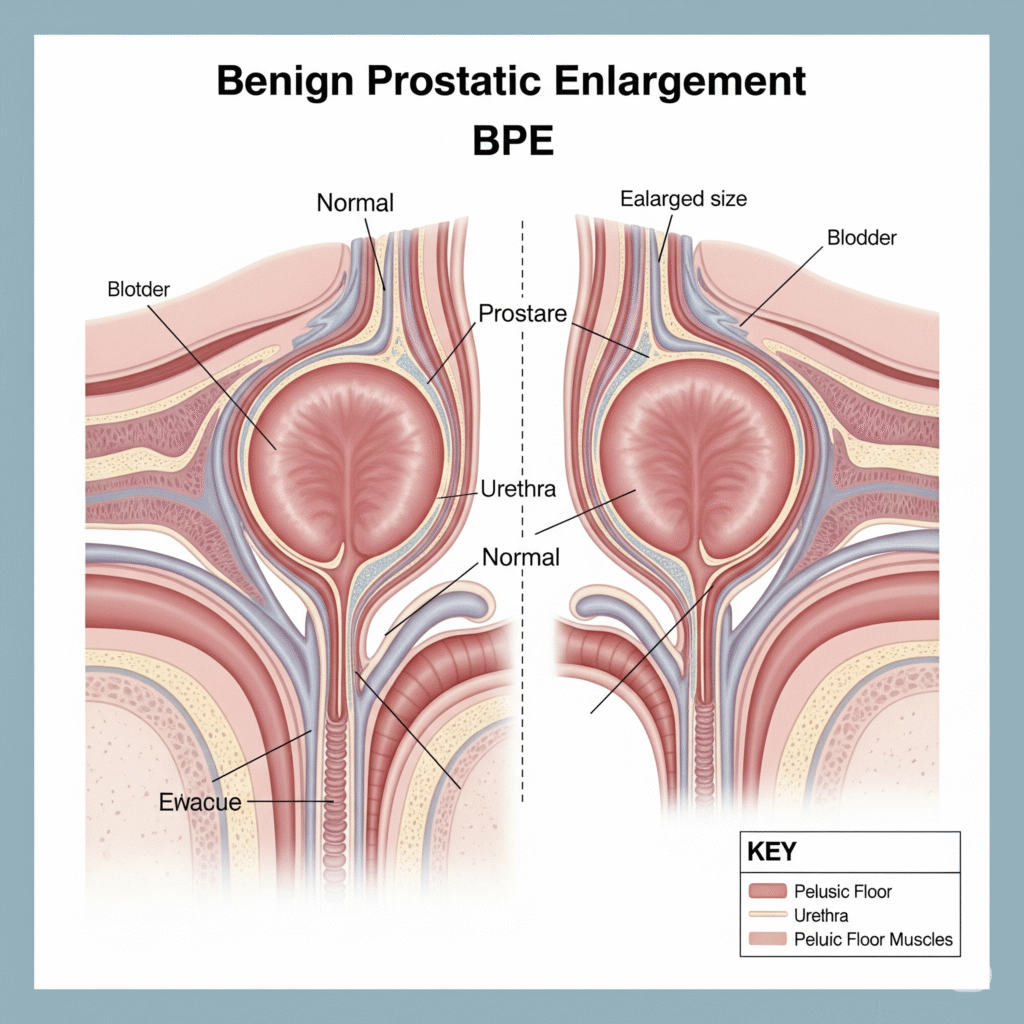Benign prostatic enlargement
Introduction
Mental prostatic enlargement (BPE) is a very common condition, especially in old men. It is estimated that about 50% of men aged and above are due to the experience of low urinary tract symptoms (LUTs) due to the outlet obstruction (BOO) of the bladder due to BPE. The underlying histological change responsible for the BPE is benign prostatic hyperplasia (BPH).

Types of Benign prostatic enlargement
Lateral lobe growth
1. The most common type.
2. The extending of the right and left side side of the prostate involves the expansion of the right and left side.
3. From both sides leads to compression of the urethra, causing urinary obstruction.
Global/generalized increase
1. All lobes of prostate (lateral, mean and anterior) are increased.
2. Important low urinary tract symptoms can be caused by severe urethra compression.
Odd growth
1. A lobe (usually a lateral one) increases more than the other.
2. Still can lead to important symptoms depending on the degree of urethra compression.
Sub -related or micro -increase
1. Histological evidence of BPH without significant increase in prostate volume or symptoms.
2. Often other reasons show the combination of imaging or during surgery.
Causes BPE (Benign Prostatic Enlargement)
- Aging: The most common cause; The prostate goes to expand naturally with age.
- Hormonal changes: Increase in dihydrotestosterone (DHT) and imbalance in testosterone and estrogen levels contribute to prostate cell development.
- Genetic factors : Family history of BPH or prostate disorders increases the risk..
- Testosterone Influence : Even normal levels of testosterone can stimulate prostate growth over time.
- Estrogen accumulation : In aging men, relatively high estrogen levels can increase the activity of DHT in prostate.
- Chronic inflammation : Long -term inflammation in the prostate can cause tissue remodeling and growth.
- Lifestyle : Obesity, lack of physical activity, and poor diet can contribute to hormonal imbalance and BPE.
- metabolic syndrome : Conditions such as high blood pressure, high blood sugar and abnormal cholesterol levels are associated with increasing risk of BPE.
- Smoking and alcohol : These indirectly can contribute to vascular health and hormone balance deteriorating.
- Low cell death (apoptosis) : The imbalance between cell growth in prostate and cell death leads to its gradual increase.
Clinical features of BPE:
Voiding difficulties
such as hesitant, weak urine stream, and a sense of imperfect bladder emptying are common.
Storage symptoms
such as urinary frequency, urgency and urge incontinence can also occur, but are not specific to BPE.
Acute urinary retention
can suddenly introduce, often begins with alcohol, constipation, or infection, causing a painful, deformed bladder.
Chronic urinary retention
can gradually develop and lead to kidney problems such as hydronephrosis and kidney failure.
The IPSS (International Prostate Symptom Score)
is used to assess the severity of symptoms and involves a quality-life question.
Symptoms associated with Benign Prostatic Enlargement
Doubt Delay or difficulty in starting the flow of urine, often requires additional effort to start urination.
- Weakened urinary stream A noticeable decrease in the force of urine stream, which takes longer to empty the bladder.
- Disrupted urine During an attempt to urinate, the flow of urine may begin and stop repeatedly.
- pee There is a need to push or tolerate with abdominal muscles to start or continue urinary flow.
- Incomplete bladder Even after urinating, the person feels as if some urine is still left in the bladder.
- Urinary frequency Urge to urinate more often than normal, especially during the day, sometimes every 1-2 hours.
- Nocturia Wake up several times during the night to pass urine, which can disrupt sleep and cause fatigue.
- Urgency and request Suddenly to urinate, strong urges that can be difficult to control, potentially leading to accidental leakage before reaching the toilet.
Investigations in Benign Prostatic Enlargement
- BOO due to BPE is primarily diagnosed based on clinical symptoms and physical examination.
Uroflowmetry (flow meter) is used to measure urine flow rate and assess obstruction severity.
Measured using ultrasound to determine how much urine remains in the bladder after voiding.
Assessed through Transrectal Ultrasound (TRUS) to evaluate the size of the prostate gland.
Used when symptoms are unclear or mixed (both voiding and storage symptoms present), or when:
Voided volume is <150 ml, or
Flow rate is >10 mL/s but obstruction is still suspected.
Should be checked if any of the following are present:
Palpable bladder
Nocturnal enuresis (involuntary urination during sleep)
Recurrent urinary tract infections (UTIs)
History of renal stones
If renal function is found to be abnormal, ultrasound imaging should be used to look for signs of urinary tract obstruction.
